| 24mm |
$1,365 average price |
|---|---|
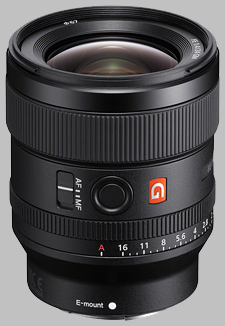
|
|
Lab Test Results
Your purchases support this site
Buy the Sony FE 24mm f/1.4 GM SEL24F14GM
Sony FE 24mm f/1.4 GM Review
by Andrew Alexander | Posted 02/19/2019
Field Test by Jaron Schneider | Posted 09/20/2018
Updates:
09/20/2018: Field Test & Gallery Images posted
02/19/2019: Full Review added
Released in October 2018, the Sony FE 24mm f/1.4 GM is the eight addition in Sony's G-Master series of lenses. G-Master lenses are touted as premium products, with an emphasis on superior detail when matched with high-resolution lenses, excellent bokeh performance, and high-end reliability.
The lens was designed with the a full-frame 35mm digital sensor in mind, and is also compatible with cameras using an APS-C sized sensor.. On those cameras, the lens will produce a field of view of approximately 36mm.
The lens takes 67mm filters, ships with the ALC-SH154 petal-shaped lens hood, and is available now for approximately $1,400.
Sharpness
Sony claims "spectacular resolution even at f/1.4", and based on the test results for sharpness, we're inclined to agree. Optimal sharpness is achieved at f/5.6, but performance at other, faster apertures is very good as well. It's not likely you will see a practical impact of the slight corner softness that's noted in our test results in the faster apertures, but if your eye is super-critical, performance at f/1.4 is perhaps the only noteworthy standout. We're talking about corners that test at 2 blur units, sloping to a central region of the image that's approaching 1 blur unit; not a big deal, indeed. And stopping down does remove almost all of this slight corner softness, until it's almost tack-sharp at f/5.6.
Diffraction limiting begins to appear at f/8, but it isn't until the lens is fully stopped-down at f/11 that there's any practical impact on sharpness. At f/11 it's showing the same level of sharpness we see at f/1.4; f/16 is demonstrably a bit less sharp.
Chromatic Aberration
CA tolerance in the Sony 24mm f/1.4 is extremely well-controlled, regardless of the aperture selected. In this lens, Sony has specifically used "a new optical design incorporating two precision XA elements" to combat sagittal flare. This type of flare is notable for distorting point light sources into (as Sony puts it) "a bird spreading its wings". It's most obvious in astrophotography, where stars are all point light sources, and indeed, in our limited field testing, it appears to work as intended.
Shading (''Vignetting'')
The Sony 24mm f/1.4 is prone to corner shading, though with post-processing this shouldn't be an issue. On a sub-frame NEX-7, the extreme corners are 2/3 of a stop darker than the center at f/1.4; stopping down to f/2 or any other aperture, the extreme corners are a half-stop darker than the center.
On the full-frame A7R however, it's somewhat more significant: at f/1.4 light falls off to make the extreme corners 1 1/4 stops darker than the center. At f/2, this falloff lowers to around a full stop; at f/2.8, this falloff hovers at just over 3/4 and stays there for all other apertures.
Distortion
The 24mm f/1.4 GM does very well to restrict distortion, showing less than +0.1% barrel distortion in the corners when mounted on the NEX-7. On the Sony A7R, there's ever so slightly more distortion: on average, this is +0.1% barrel distortion, but curiously we note a maximum result of around -0.4% pincushion distortion. With numbers like these, however, the image is practically undistorted.
Autofocus Operation
The lens uses an Direct Drive SSM (supersonic wave) focusing motor, making it compatible with all modern Sony camera bodies. Autofocus is fast, about one second to slew through infinity to closest focus, and is near silent. Autofocus results can be overridden at any time by just turning the focus ring.
Macro
The 24mm f/1.4 GM makes a poor macro lens, with just 0.17x magnification and a minimum close-focusing distance of 24cm (under a foot).
Build Quality and Handling
Sony rightfully boasts that the FE 24mm f/1.4 GM is smallest and lightest lens in its class (of 24mm full-frame prime lenses), at 445 grams (just over 15oz). Since none of Sony's modern camera bodies are particularly large, the balance feels good on both the APS-C and A7-series cameras. The lens mount is metal and the 67mm filter threads are plastic. Being a G Master lens, thee 24mm f/1.4 has a dust and moisture resistance design, including a thin gasket around the lens mount.
The lens sports some interesting and innovative features that play well with the Sony feature set. A pretty standard lens switch allows the user to enable or disable autofocus (AF/MF) and a button above this switch allows the user to assign a custom function (for example, a touch of the button allows the user to bring up guidelines for quick framing, or adjust the white balance).
The lens also features an honest-to-goodness aperture ring. It's a high-tech version of course, being Sony, and includes a "Click" switch so you can feel the aperture changes or not, but it's refreshing to see an actual aperture ring rather than just being adjustable from the camera. The ring features 1/3 aperture increments from f/1.4 to f/16, and an "A" for automatic aperture selection. The aforementioned "Click" switch allows the user to enable or disable click-stops when selecting aperture. In video shooting this is particularly useful, as the operator can now smoothly and silently change apertures while shooting; for stills shooting, the tactile feel of changing apertures can be more deliberate.
The 3/4-inch wide focus ring is rubber, a series of ribs running parallel to the body of the lens. There's a slight bit of resistance as you rotate the ring, but given the focus-by-wire design of the lens, the ring will continue to turn indefinitely, with no hard or stops at the either end of the focusing range. There is no lens extension during focusing.
Sony has put a substantial effort into improving the quality of out-of-focus elements in images produced by this lens, devoting eleven rounded diaphragm blades to make up the aperture mechanism.
The ALC-SH154 lens hood is around 1 5/8 inches in depth. The hood is a bayonet-mount that reverses onto the lens for easy storage, but denies access to the focus ring in this configuration. The lens is nicely resistant to obvious flare from bright light sources such as the sun, but the hood works well to reduce generalized veiling flare.
Alternatives
To stay within the Sony ecosystem, there aren't many alternatives in this category of lens. If you're a Sony shooter, your only other option is the Sony 24mm f/2 SSM Carl Zeiss Distagon T*, but you'd have to use an adapter to fit it to a NEX or A7 body (the Carl Zeiss lens was designed for A-mount DSLRs). It has a maximum aperture of f/2, and as it is still on shelves at the same price point, there's little reason to prefer it over the newer lens.
Sigma does offer its 24mm f/1.4 DG HSM "Art" lens in the Sony FE-mount but we have not yet tested this lens, so we can't confirm whether it is worse or better.
Compared to similar lenses in the Nikon and Canon camps, the performance of the Sony 24mm is noticeably better when used wide open at f/1.4, but as the lenses are stopped down, they all produce excellent results.
Conclusion
Perhaps the most interesting feature of this lens is its price point, despite its designation and specs as a top-tier G Master lens. While the Nikon and Canon equivalents (released in 2010 and 2008, respectively) retail at around $1,600 - $2,000, the Sony lens is aggressively priced at $1,400. Excellent sharpness, extremely well-controlled distortion, chromatic aberration, and special attention to sagittal flare - what's not to like in this lens? Perhaps the only test results worthy of note is somewhat high corner shading, and in the days of Lightroom, you can dial in some brightness to the corners to correct this if it's even a problem. Overall, the Sony FE 24mm f/1.4 GM is an amazing full-frame lens, and and an obvious choice as our pick for Best Wide Angle Prime Lens of 2018.
• • •
Sony FE 24mm f/1.4 GM Review -- Field Test
A wide-angle stunner
by Jaron Schneider | Posted 09/20/2018
Sony's latest G-Master lens goes wide and fast, and thanks to some interesting technological achievements, is unique in a category filled with excellent options. The 24mm f/1.4 GM is Sony's eighth addition to their G-Master line, and it came with the descriptors "small, light and bright" when shown to us by the engineers. After holding the lens and shooting with it for a few hours, I do agree with their assessments in that regard: it probably is the lightest and smallest 24mm lens I've ever held, and easily that when you compare it to the other full-frame f/1.4 lenses on the market.
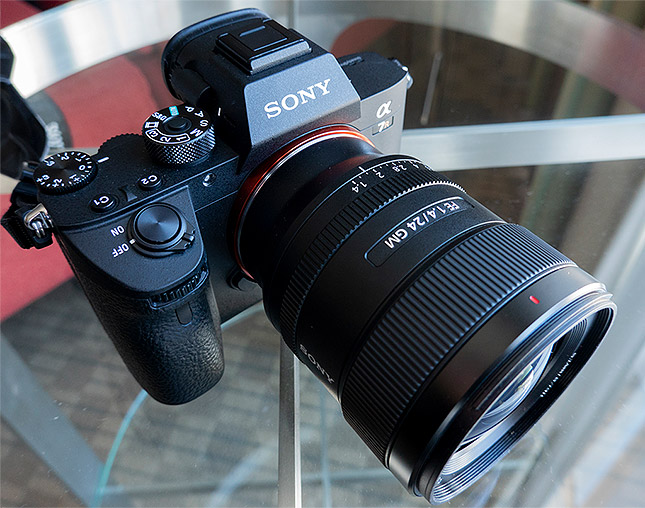 |
Sony touted the lens' sharpness from not only the center of the frame (though they did take special note to state that it should be extremely sharp there), but also its ability to retain a high degree of sharpness and contrast all the way out to the edges, even wide open and fully closed. Looking at the MTF charts that were shown to us, only Sigma's 24mm f/1.4 comes close to what Sony is claiming, and even they show a significant contrast falloff as the lens fully closes to f/16.
Sony's MTF chart did not show any such steep falloff.
I'm not one for relying on charts, though. Personally, I decide if a lens is worth adding to my collection based on trying it in the field. So, despite having a very limited time with the lens, I did my best to capture a wide range of images that the 24mm might be best for.
Unfortunately, there was not time to do any astrophotography (and the whole time spent with the lens was in San Francisco proper, therefore light pollution would have been a problem anyway), so that will have to wait for another test. I bring this up specifically because Sony heavily touted a lens element arrangement that would prevent sagittal flare, the type of flaring seen in some astro photos where the stars appear as stretched, flared lights rather than pinpoint dots. This would be a huge boon, as all three major competitor lenses suffer from some level of sagittal flare, from very noticeable to just barely tolerable. For Sony to have been able to basically eliminate it and also put that lens technology into a casing nearly half the weight of its competition would be rather impressive.
What I can speak to, however, is how the lens does with regards to focusing and sharpness, two other areas in which Sony heavily emphasized that the 24mm f/1.4 GM should excel.
Focusing
Sony was rather proud of their ability to make a lens this wide and this fast that also could close focus at an impressive 0.24 meters (or somewhere in the ballpark of 9.4 inches). That doesn't sound particularly close on paper, but when you combine it with such a wide angle perspective, it allows you to get some particularly unique images.
 |
A7R III: f/1.4, 1/30s, ISO 200, -1EV Note: This image has been edited. Please click for the original. |
 |
A7R III: f/1.4, 1/30s, ISO 160, -1EV Note: This image has been edited. Please click for the original. |
In both of the above examples, I personally felt like I was nearly to the point of shoving the front element of the lens directly into the subject, I was so close. This is of course not the reality of the situation, but when looking through the EVF, the way the field of view is presented, the tips of the evergreen leaves and the sides of the redwood tree felt right up against my eye. It was a really fun and unusual perspective, and I really do like how good the images look.
Those are rather "artsy" and perhaps only nice as a fun example of what is possible, but what about how the lens does with a relatively close subject that might actually be useful to a professional shooter?
 |
A7R III: f/1.8, 1/8000s, ISO 100, +0.3EV Note: This image has been edited. Please click for the original. |
So while I'm not as up-close here as I was for the shots of the pine needles or the side of the redwood, I am still very cozy with this glass of IPA.
I found that the focusing speed of this lens was excellent, but I did notice that in some cases, like in the image of the beer above, the plane of focus is so slender that I did not necessarily nail the focus on the glass like I was hoping for. That combined with the fact that shooting a liquid with a shallow depth of field is already challenging resulted in me getting slightly lower on the glass than I wanted. My goal was to hit the rim of the glass, but instead I got the center of the glass. And this wasn't even with the lens fully wide open! This and the following shot were both captured at f/1.8.
I also noticed that when using continuous autofocus set to "Wide" on the A7R III, this was tending to happen in quite a few of the shots I tried to capture. However, I was able to adjust for it since those subjects were easier to discern through the EVF. For example, though I eventually landed the focus point I wanted on the tips of those pine leaves, it wasn't a quick and painless shot. The lens did take a few seconds to agree with me on what we were going to focus on.
Here is another shot of that beer, but taken from slightly farther away. As you can see, nailing focus was much easier thanks to my greater distance (obviously).
 |
A7R III: f/1.8, 1/8000s, ISO 100, +0.3EV Note: This image has been edited. Please click for the original. |
You can also take note of that shimmering water, which is providing a really lovely fully circular bokeh. I'll talk a bit more about that later.
Subject Isolation
I've spoken to a few portrait photographers over the last few months, and several of them informed me of their new favorite focal length for their work: 24mm. It's "the new hotness" as they say. I was at first a bit confused on why they like it, as conventional thinking will tell you that 24mm will severely distort a person's facial features if you're not careful. But when I was s showed what you can get with this wider focal length, I was sold.
While yes, you can get some distortion of features, it might be worth it if it means you also can reveal a subject's surroundings in an interesting way. From a distance, a full field of view of both the subject and the environment is revealed, and those surroundings play a role in the image's ability to tell a story. When you come in, that same background can persist, but you can also choose to show more of a person while also isolating them beautifully using shallow depth of field.
Those options continue to be the case with Sony's 24mm f/1.4. As you can see below, this portrait shows not only the subject in crisp, sharp focus, but also reveals more about them and their surroundings.
 |
A7R III: f/1.4, 1/30s, ISO 160, -0.7EV Note: This image has been edited. Please click for the original. |
This is a more "editorial" look than you get with more telephoto lenses, and perhaps that is what I like about it. As a documentarian, I hardly ever just want to shot a subject standing alone and without context. This 24mm lens gives me that context, and I enjoy what that can add to the frame.
 |
A7R III: f/1.4, 1/320s, ISO 100, -2EV Note: This image has been edited. Please click for the original. |
If, however, you wanted to get a similar frame but not distract with background elements, that too is possible thanks to the bright f/1.4 aperture. In the shot above, I was able to get absolute tack sharp focus on the subject's eye but isolate her thanks to a near-immediate shallow break in the depth of field.
This is actually a good way to show how that thin depth of field actually works in practice. Back at the top, in the shot of the redwood tree bark, it was apparent how thin the focus plane is, but here you can see that even when I take several steps back (I was a good two feet away from the model in this photo), at f/1.4 the focus plane is no more than five or so inches. This is beautiful in that it really isolates a subject nicely, but it's also tricky since, if you miss focus, there is very little wiggle room to hide it.
Image Quality
Regardless of how the lens operates in the field, there is one thing that is apparent in images taken with this lens: the FE 24mm f/1.4 GM is sharp as heck. Either wide open or fully closed, there are several examples of this lens handling its full aperture range with relatively equal results. For example:
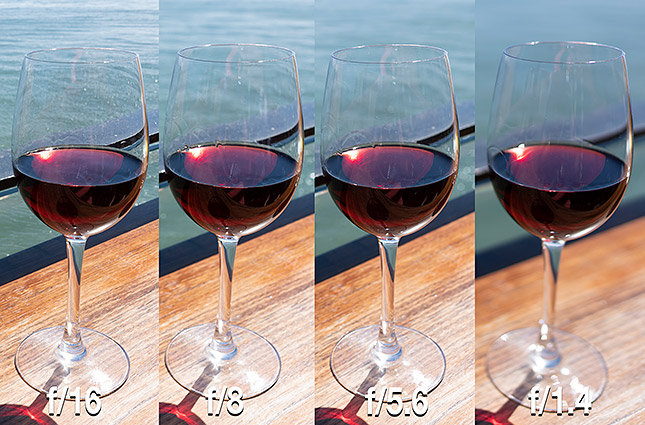 |
Please click to this comparison image at full resolution. |
Through this whole range, you can see that the in-focus segments of all four images are basically equally sharp. That said, I will hearken back to what I said earlier about the challenges shooting at f/1.4: nailing focus can be hard. In my image here, I did get a piece of the glass in focus, but it wasn't until I got back to my desk did I realize it was the very furthest forward bit of the wine in the glass, and not the rim of the glass as I intended.
In other shots I captured at f/16, I was pleased overall with the quality of the images. Shooting fully stopped down also granted a pleasant starburst effect when shooting into the sun.
 |
A7R III: f/16, 1/30s, ISO 800, -1.7EV Note: This image has been edited. Please click for the original. |
Shooting fully open, though, is easily my favorite part of this lens. As evidenced by images above and a few more below, the focus plane is not only beautifully thin, but also incredibly sharp.
 |
A7R III: f/1.4, 1/100s, ISO 100 Note: This image has been edited. Please click for the original. |
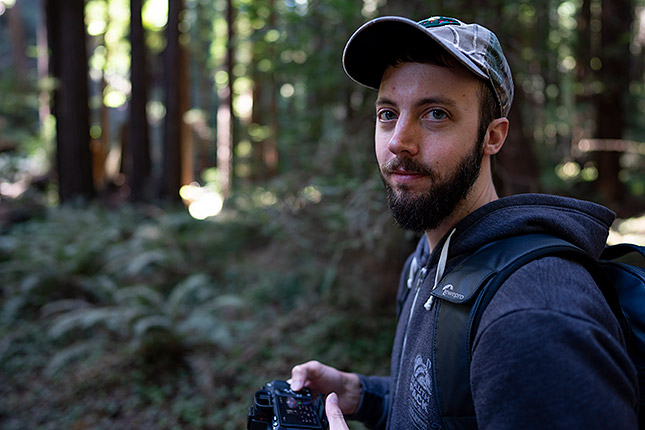 |
A7R III: f/1.4, 1/50s, ISO 100, -1.7EV Note: This image has been edited. Please click for the original. |
 |
A7R III: f/1.4, 1/160s, ISO 100, -0.7EV Note: This image has been edited. Please click for the original. |
It should also be noted that in all my images of the glassware above, as well as that last image of the light fixture shaped like a beer hop flower, the chromatic aberration is very well controlled. I did see a bit of purple and green fringing at the base of the beer glass right where the sun directly reflects off the bottom of the glass, but that's it. It's not super severe, and it's very easily correctable in post. More testing will have to be done to see exactly where the aberrations fall off when stopping down, but from what I'm seeing in my time with this lens, I don't have any qualms at all about shooting with the 24mm f/1.4 GM wide open, even in bright daylight.
 |
Please click to this image at full resolution. |
In the image below, it appears that Sony's promise of edge to edge sharpness was upheld, as even zoomed in to 100% I see very even sharpness across the frame. There doesn't appear to be any kind of stretching or smudging of the pixels. Everything is even, crisp and sharp.
 |
A7R III: f/3.2, 1/3200s, ISO 100, +0.3EV Note: This image has been edited. Please click for the original. |
Other Notes
Looking only at pure image quality, I would be hard pressed to find much at all to complain about with the FE 24mm f/1.4 GM. But when you combine the image quality with the fact that it's so small and lightweight, then you really start to marvel at how nice this lens is.
It fits in the palm of my hand and weighs just 445 grams. When it's on the front of the A7R III, I don't even mind using the sub-par straps that come with the camera, it feels so light and easy to carry.
The fact that there is a click/de-click switch on the barrel of the lens means that this optic will appeal to both photo and video shooters. Both autofocus and manual focus is smooth, and AF specifically seems to be quick and accurate, though it can often be hard to isolate your focus point if you're wide open, since the depth of field is so thin. I recommend choosing a point manually or using Eye-AF if you're shooting portraits.
As a side note, Sony's excellent Eye-AF makes this lens a lot more usable since it has a reliable way of regularly hitting the eye. Without that Eye-AF, I would say it is considerably harder to keep the focus where you would want it in portraits.
 |
A7R III: f/1.4, 1/30s, ISO 125 Note: This image has been edited. Please click for the original. |
This focal length, and of course the very bright aperture, means that this lens is going to be very nice for night photography of all kinds. While I mentioned that astrophotography should be especially good, I've yet to test it. I did, however, get a few moments to try some long exposures of the city from the San Francisco waterfront, and I wasn't disappointed.
 |
A7R III: f/1.4, 3.2s, ISO 50 Note: This image has been edited. Please click for the original. |
 |
A7R III: f/1.4, 3.2s, ISO 50 Note: This image has been edited. Please click for the original. |
In that second shot, a few stars are visible and... I don't see any sagittal flare. That bodes well.
 |
A7R III: f/1.4, 1/30s, ISO 125, -0.7EV Note: This image has been edited. Please click for the original. |
In my short time with the Sony FE 24mm f/1.4 GM lens, it pretty much lived up to the high expectations that Sony laid out for it when they introduced us to it. They promised light weight, great bokeh, fast aperture, excellent corner-to-corner sharpness, and strong aberration control. Based on the shots I was able to capture with it, those claims hold true. We have a lot more to test, especially with regard to their astrophotography aspirations for this lens, but as it stands today I am very impressed with what Sony was able to accomplish here. Their lens is easily as sharp or sharper than its competition, but comes in significantly lighter, too. Hard not to be on-board with that.
• • •
Sony FE 24mm f/1.4 GM Overview
Sony's latest prime, 30th total full-frame E-mount lens, and 8th addition to the G-Master line, is the FE 24mm f/1.4 GM. A product of their latest lens technology, the 24mm f/1.4 G-Master uses a newly-developed Direct Drive Supersonic Motor (DDSSM) that provides three times greater thrust compared to previous iterations of the technology, resulting in a faster response, higher positioning accuracy, and quiet operation.
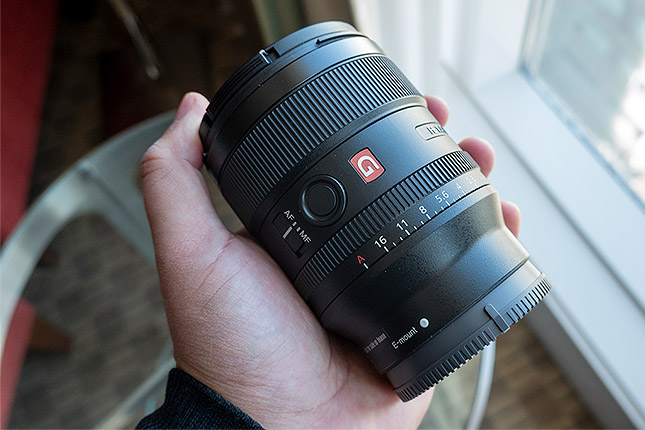 |
Additionally, Sony designed the lens to be sharp from corner to corner, at all apertures using a new optical design that is not shared by any other lens manufacturer.
The 24mm f/1.4 GM is also capable of very close-focusing distances, allowing for unique angles and the ability to blow backgrounds out of focus with a smooth, circular bokeh.
One of the standout features of the 24mm f/1.4 GM is its size and weight: it's a mere 445 grams and is extremely compact.
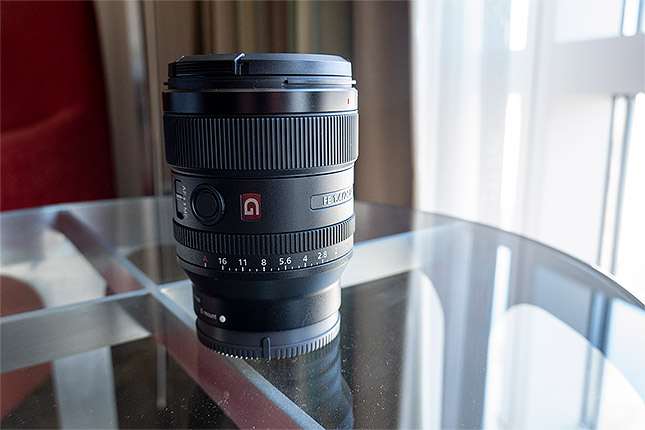 |
Features
New and unique optical design
The Sony 24mm f/1.4 GM utilizes 13 elements in 10 groups, with two XA elements and three ED glasses to deliver outstanding resolution. Additionally, Sony's front element is aspherical, spurning the design choices of the competition who all use the aspherical element as the second lens optic. According to Sony, this design choice has led the 24mm f/1.4 GM to hit spectacular center detail even wide open, and with no significant drop in quality or contrast at the corners. With regards to the second accomplishment, they would be the only manufacturer of a 24mm f/1.4 to attain this feat, as all other makers suffer significant contrast issues in their corners wide open (when comparing MTF charts).
Beautiful bokeh and close-up capability
Due to a circular 11-bladed aperture, the 24mm f/1.4 GM can achieve circular bokeh in out-of-focus areas that results in a smooth, "buttery" effect for isolating subjects when shooting wide open. Additionally, the 24mm can focus quite close, with a minimum focus distance of just 0.24 meters (0.79 feet), allowing for unique angles and a razor-thin focus plane.
The lens can open as wide as f/1.4 and close down as far as f/16.
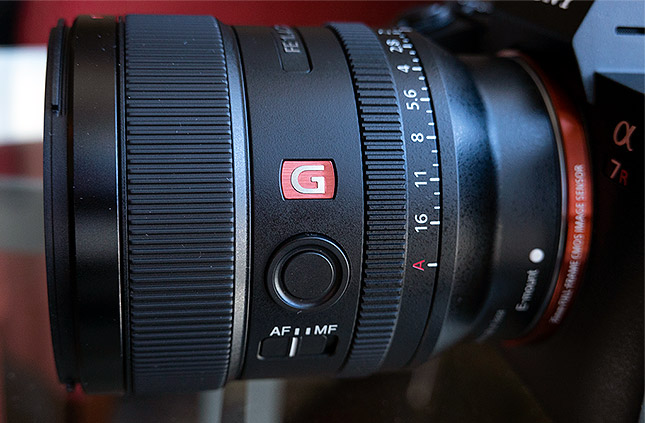 |
Suppressed sagittal flare, limited focus breathing
An often-overlooked feature is a lens' ability to suppress sagittal flare, especially in the corners of wide angle lenses. For astrophotography, a lens that can properly keep sagittal flare down is critical for pinpoint star light capture. The suppression is achieved via the aforementioned two precision XA elements. Point light sources retain their points, rather than spread the light.
Focus breathing is effectively minimized by a precision internal focus mechanism.
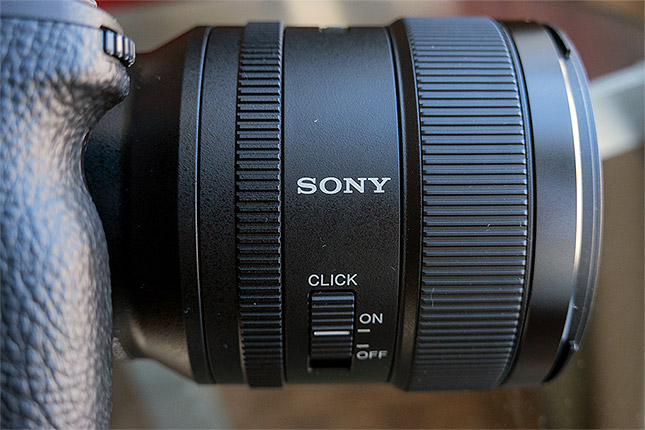 |
Custom function button, click/de-clicked aperture
A custom function button that can be assigned from the camera's menu can be found on the barrel of the lens, as well as a click/de-click aperture switch that allows both photographers and filmmakers to use the lens equally and without any limitation.
Price and Availability
The Sony FE 24mm f/1.4 GM has been available since October of 2018 and retails for $1399.99 US ($1899.99 Canada).
Sony FE 24mm f/1.4 GM SEL24F14GM
Your purchases support this site
Sony E-mount - Black
Sony FE 24mm f/1.4 GM SEL24F14GM User Reviews
The Sony FE 24mm f/1.4 GM SEL24F14GM doesn't have any user reviews yet!







